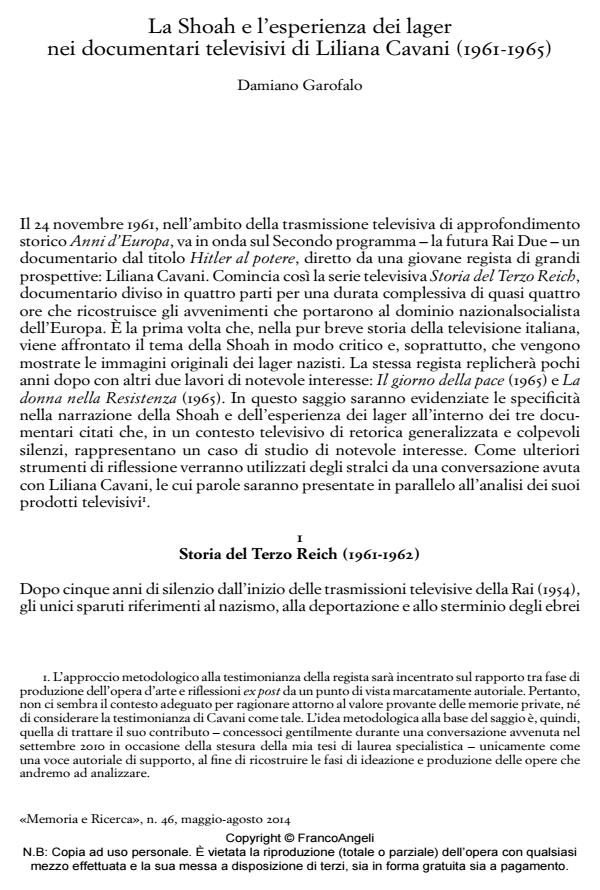The Holocaust Memory and the Nazi Concentration Camps Experiences in Liliana Cavani’s TV Documentaries (1961-1965)
Journal title MEMORIA E RICERCA
Author/s Damiano Garofalo
Publishing Year 2014 Issue 2014/46
Language Italian Pages 19 P. 173-191 File size 99 KB
DOI 10.3280/MER2014-046012
DOI is like a bar code for intellectual property: to have more infomation
click here
Below, you can see the article first page
If you want to buy this article in PDF format, you can do it, following the instructions to buy download credits

FrancoAngeli is member of Publishers International Linking Association, Inc (PILA), a not-for-profit association which run the CrossRef service enabling links to and from online scholarly content.
Liliana Cavani is well-known as the director of the controversial Holocaust fi lm The Night Porter (1974), which inspires the birth of the new cinematographical genre of Nazisexploitation. In order to trace Cavani’s interest on the Holocaust theme we have to come back to the early 60’s, when the young director starts working for the national broadcasting television RAI. In the fi ve years between 1961 and 1965, in fact, Lilian Cavani directs three documentary fi lms: a four-episodes serie called History of the Third Reich (1961-1962); a documentary about the divided World War II memories between two generations in post-war Europe, The Day of the Peace (1965); fi nally, The Woman in the Resistance (1965), a fi lm about the role of Italian women during the Partisan struggle, where she also interviews several Jewish Italian women who were deported between 1943 and 1945. Each one of these productions has different and specifi c modalities of dealing with the Holocaust memory. But the relevance of these fi lms lays in the fact that they represent the fi rst attempt of the Italian television to deal with the memory of the Holocaust, and this happens through the screening of both audiovisual and oral sources. Until then, no previous visual expressions have described the Italian responsability in the deportation of thousands of Italian Jews. The paper is structured by using several kind of sources: audiovisual archives, production and distribution strategies, an original interview to Liliana Cavani about her early carreer.
Keywords: Holocaust Memory, Italian Television, Liliana Cavani, Oral History, Public Memory, Audiovisual Sources
- ‘Remember Without Hate’: The Holocaust as European Memory in 1960s’ Italian Television Emiliano Perra, in Journal of War & Culture Studies /2018 pp.223
DOI: 10.1080/17526272.2018.1490073
Damiano Garofalo, La Shoah e l’esperienza dei lager nei documentari televisivi di Liliana Cavani (1961-1965) in "MEMORIA E RICERCA " 46/2014, pp 173-191, DOI: 10.3280/MER2014-046012